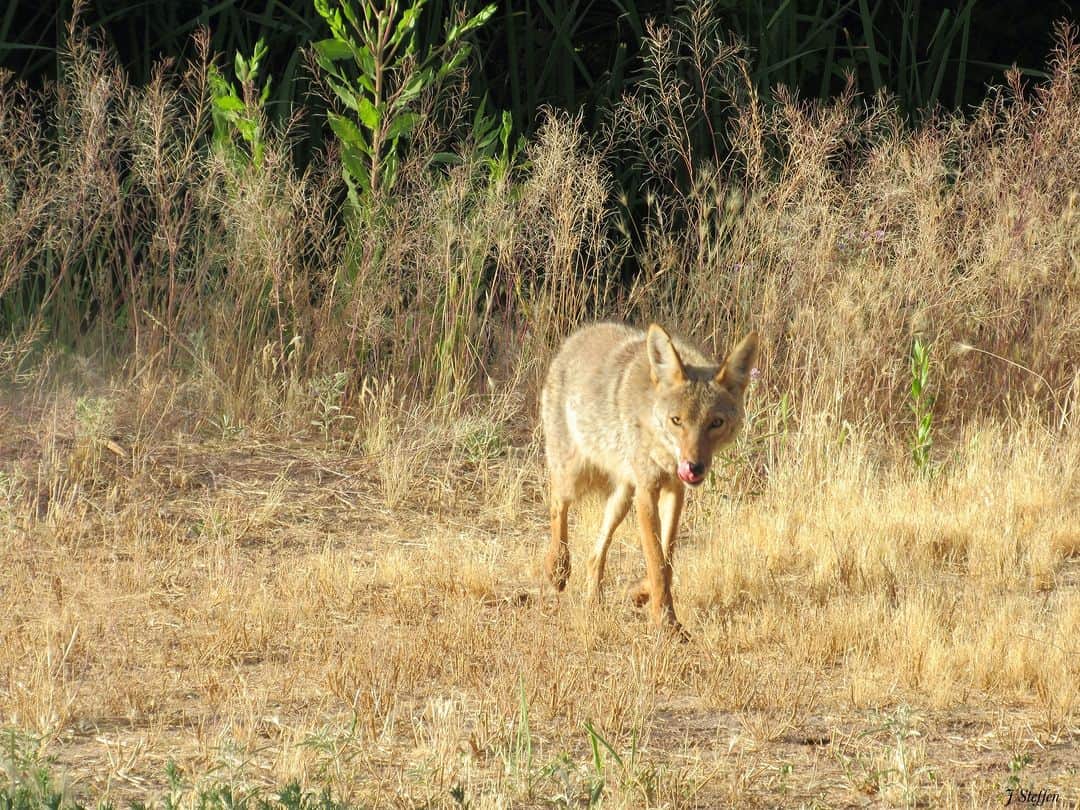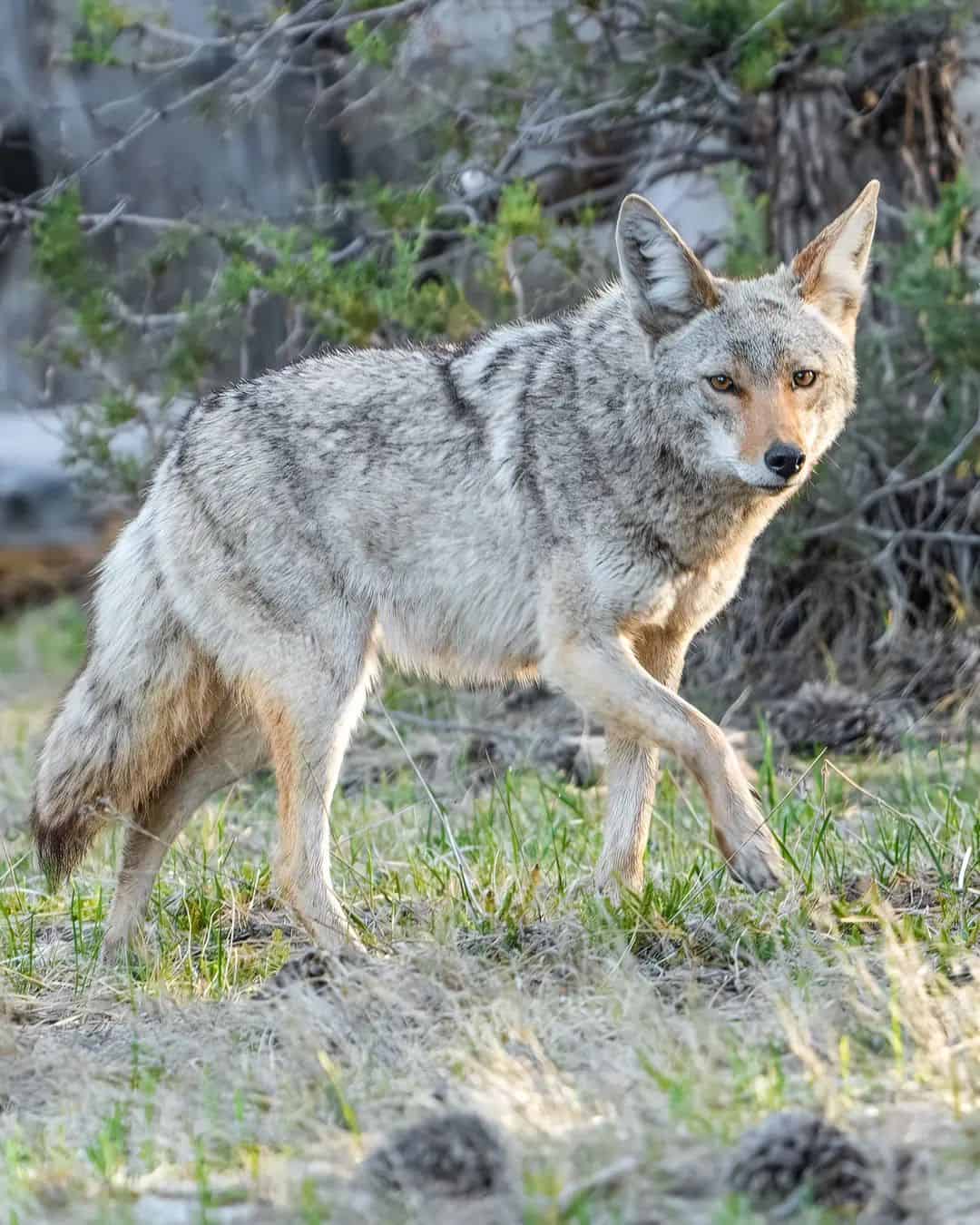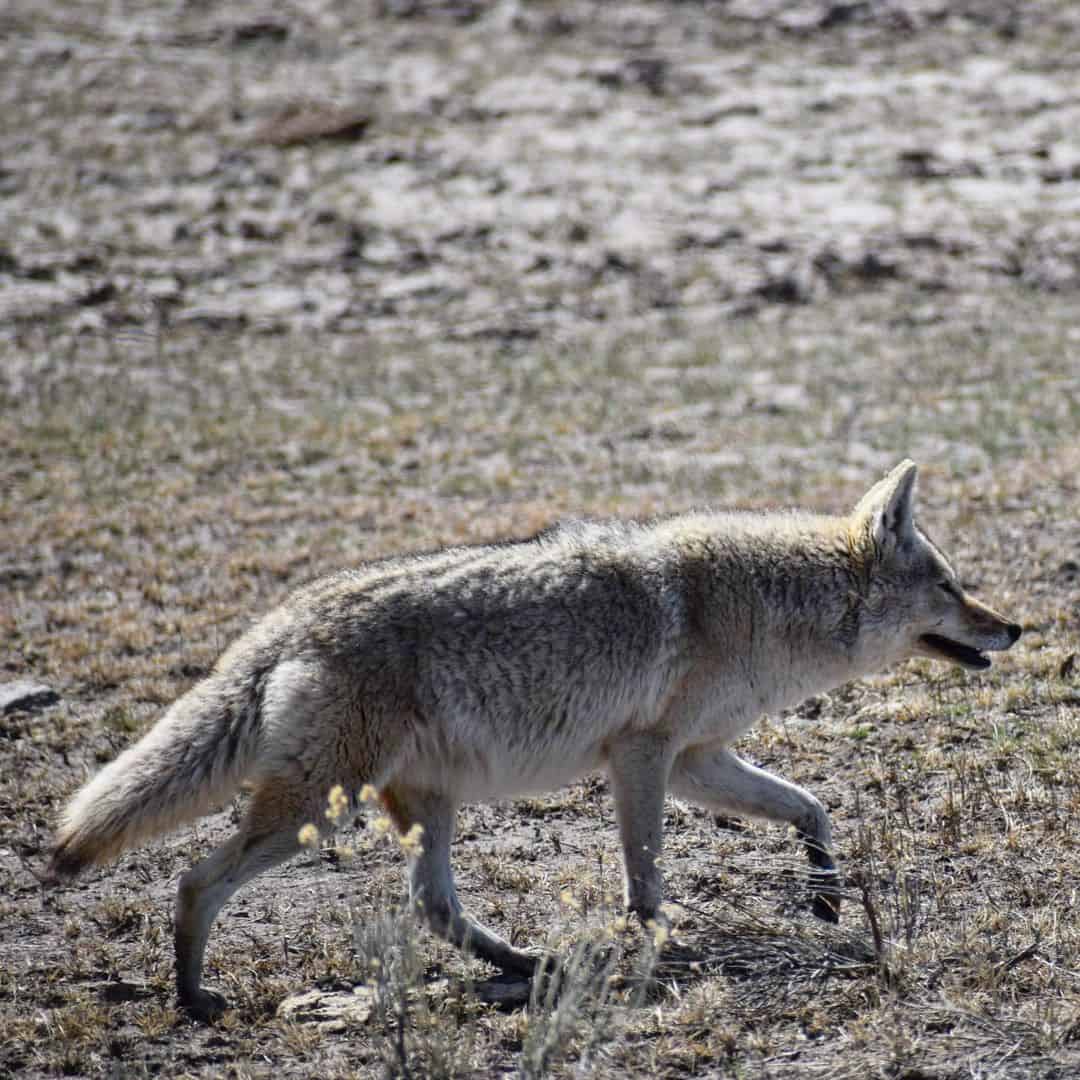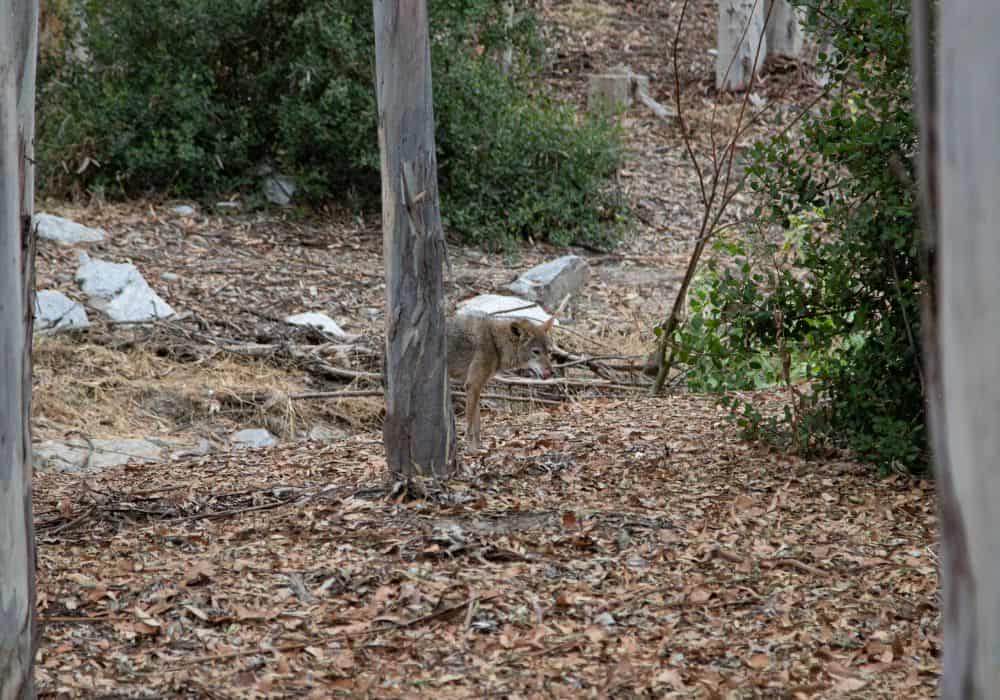Have you ever stumbled across a coyote or its den near your neighborhood?
Today, coyotes have become ubiquitous across urban and suburban areas. This is because they are drawn to abundant food sources and green spaces in these areas.
What’s even more interesting, coyotes are incredibly adaptable. As opportunistic omnivores, these pests can change their diets based on what type of food is available. This raises the question “Do coyotes eat dogs”.
Well, this comprehensive article will answer this question and more. So stick with us as we explore coyote dietary habits and determine whether dogs can become part of their menu.
Can Dogs Be Part of The Coyote’s Diet?
In the wild, coyotes often feed on small rodents, bird eggs, deer, and even plants and fruits. But in cities these furry animals supplement their natural diet with human-based food sources, including:
- Garbage: Coyotes will get into garbage cans or trash bins to eat meat scraps and other table scraps dumped by humans.
- Bird Feeders: Contrary to belief, coyotes are not attracted to seeds in the bird feeder. Instead, they are after the small animals attracted to the bird seeds that fall to the ground, like rats, voles, and squirrels.
- Pet Food: Some pet owners usually leave their pet food outside, giving coyotes a fresh meal each night. These animals can also get drawn to the mice and rats attracted to left-out pet food and water dishes.
Now let’s address the elephant in the room–can your dog fall prey to coyotes?
The answer is yes. Given the opportunity, a hungry or desperate coyote might attack and kill your dog. While these attacks are rare, small dog breeds (under 50 lbs or 22.7kg) are highly susceptible to coyote attacks. These breeds include, but not limited to;
- Chihuahuas
- Yorkshire Terrier
- Shih Tzus
- Pomeranian
- Dachshund
- Pug
- Maltese Dog
In neighborhoods with a high coyote population, medium and large-size dog breeds might not be safe. Coyotes sometimes hunt in packs and take down dogs as big as 70 lbs or more.
But coyotes also run the risk of being killed by the dog. Like coyotes, our canine friends are protective of their domain. So, if a lone coyote wanders unknowingly into your dog’s territory, it might find itself embroiled in a fight with your dog and get fatally wounded or killed.
9 Ways to Keep Your Dog Safe from Coyotes
Whether you have a small or big dog, it’s crucial to learn how to keep him safe from these wild opportunistic feeders.
Below, we have highlighted a few ways to keep your dog safe from coyotes and create a secure environment. Let’s check them out.

Image Credit: deadhorseranchstatepark
1. Recognize the Threat
As said earlier, coyotes are adaptable predators that thrive on available food resources. While coyotes are active at night, they are not strictly nocturnal. So, it’s not unusual to see a coyote during the day.
However, if it’s lurking around your property during the day, it’s a cause for concern. That is because your precious furry friend – cat or dog- might fall prey to this wild animal.
It’s better to call the authorities or local wildlife control officers, particularly if the coyote acts abnormally aggressively.
Also, you should be extra cautious if you notice increased coyote activities around your property or neighborhood.
2. Keep your Yard Secure
Did you know coyotes are excellent climbers and diggers? Well, now you know.
To keep these predators away from your home, install a sturdy fence that’s at least 6 to 8 feet in height. Also, ensure the fencing extends approximately 12 inches underground to prevent burrowing underneath.
Before installing the fence, consult your local contractor to help you select a coyote-proof material. Alternatively, consider using a coyote fence with angled climb protection or rollers (features aluminum roller rods that spin whenever the coyote tries to climb over.
3. Don’t Leave Your Dog Outdoors Unsupervised
We understand that your pups love spending time roaming around your backyard. But this exposes them to a higher risk of potential coyote attacks.
If you must leave your dog outside, keep an eye on him. You can grab your favorite book and sit on the porch while your boy plays outside. Keep in mind, coyotes rarely venture into a property if they see a human nearby.
Even if you stay indoors, ensure you have a good view of your dog from the window. In case you see your furry friend acting strangely, bring your dog inside. Maybe a coyote is lurking nearby or planning to attack.
4. Don’t Leave Your Dog Outside
Some dog owners prefer leaving their dogs outside at night. Nevertheless, if you live in an area with frequent coyote sightings, this is not a good idea.
At night or early in the morning dogs are vulnerable to coyote attacks. So, bring them inside to minimize the chances of an attack.
5. Leash Your Dog in High-Risk Areas

Image Credit: tullymt
It’s nice to let your dog off-leash in parks or when walking. However, leashing your dog might save his life, particularly in areas infested with coyotes.
Coyotes fear humans, so your presence is enough to keep them away. But if your dog is off-leash, he can easily fall prey to coyotes. Even worse, you might not get the chance to step in before your friend is injured or killed.
But that’s not all. It’s crucial to maintain confidence and an assertive demeanor when you stop a coyote while walking your dog. You can whistle, yell or shout at the coyote to prevent it from coming closer.
6. Get Rid of Any Coyotes Attractants
This is arguably the best way to deter coyote sighting in your home. Start by securing your trash.
It’s no secret that coyotes love going through garbage bins and trash cans in search of food scraps. So, the smell of table scraps in dumpsters and trash bins can attract these animals to your home.
If possible, remove your garbage cans outside at night and bring them out at dawn for collection. Alternatively, close your trash cans with a bungee cord or animal-proof lids.
Another thing, remove food scraps, pet food, and old dog treats lying in your yard. Also, cut down shrubs, long grasses, and weeds as they might attract small rodents that coyotes love.
7. Exterior Lighting Also Helps
Illuminate your backyard with flood lights to protect your dog at night. Coyotes hate bright lights because they feel exposed.
But here’s the thing: once these predators realize the bright light possesses no threat, this fear will quickly disappear. That’s why you should install motion sensor lights that will startle them and alert you of their presence.
8. Employ Deterrents
Besides motion lights, employ other effective coyote deterrents. One such deterrent is coyote vests.
These strange-looking dog jackets feature long spikes at the back. These help stop predators from attacking the dog’s vulnerable parts. Coyote vests also provide you with sufficient time to come to your dog’s aid during an attack.
Other deterrents worth looking into include:
- Motion-activated sprinklers
- Predator Urine
- Coyote hazing
- Noise
- Audible alarms
9. Stay Informed
Stay informed of coyote sightings in your locality, whether it’s through news or community forums. It also helps to share practical tips on how to keep coyotes away from your neighbors.
What Other Things Do Coyotes Eat?
Coyotes thrive in different environments, thanks to their ability to change their diet based on available food sources. That said, here’s a list of other things that these animals eat besides dogs:
- Small mammals: Rabbits, mice, moles, rodents, raccoons, and ground squirrels.
- Birds: Songbirds, thrashers, sparrows, wild turkeys, etc.
- Insects: Grasshoppers, beetles, and other arthropods.
- Fruits and Vegetables: Peaches, carrots, cantaloupe, blueberries, pears, and watermelon.
- Carrion: Decaying flesh of deer, elk, or roadkill.
- Reptiles: Snakes and lizards.
- Fish and amphibians
- Livestock: Goats, sheep, cattle, and chickens
- Crop plants and seeds: Maize, wheat, sweet corn, and other garden produce
Coyotes can Spread Diseases and Pests
Even if a coyote does not attack your dogs. It carries several diseases and pests that can get transmitted to you and your pets.
For example, coyotes can transmit distemper to your four-legged partner. In dogs, this disease can affect their respiratory system, causing them to sneeze, cough, and feel tired. Distemper also affects the dog’s nervous and gastrointestinal systems.
If you notice these signs on your dog, consult your vet promptly because distemper can be fatal.
Like raccoons, coyotes are notorious for carrying rabies. If these animals bite or scratch your dog, it might get rabies. Similarly, coyotes’ bites and scratches can spread rabies to humans.
Once infected, individuals can display several symptoms, like anxiety, tremors, hallucinations, and uncontrollable salivations. Since rabies affects the nervous system, it may cause paralysis.
But wait, there’s more:
Other coyote diseases and parasites to watch out for include:
- Canine hepatitis
- Tularemia
- Parvovirus
- Ticks
- Hookworm
- Tapeworms
- Roundworms
What to Do During a Coyote Encounter?

Image Credit: cbarry.photo
Coyote encounters are not the best experience, especially if you meet an aggressive bunch. Luckily, you can take a few steps to protect yourself and your favorite pet.
1. Stay calm and don’t panic
Coyotes are more scared of you than you are of them. But remember, these are wild animals. That means their behavior might vary depending on their familiarity with humans, the nature of encounters, or their personalities. If the coyote feels threatened, it might attack. So, stay calm and don’t show any sign of fear or aggression. By luck, the animal will run away.
2. Hazing
Shout as if your life depends on it. The loud noise will startle the coyote, forcing it to retreat. Even if it doesn’t retreat, people nearby might hear your scream and come to you and your dog’s aid. You can also throw projectiles at them like small rocks, cans, or broken pieces of sticks until they run away.
3. Keep your distance
Move back slowly to create a distance between you and the coyote while hazing. But don’t turn your back and try to run. Doing so might incite the coyote to chase you down. And trust us, these will predators can catch up with you within minutes.
4. Contact your local animal control authority
If the coyote displays aggressive tendencies or appears bold, it’s better to get reinforcements. Contact your local wildlife control department and report the encounter or sighting. These experts will handle the coyote removal, leaving your home safe.
Final Thoughts
Coyotes are not picky eaters, meaning they can consume a variety of foods. And your favorite furry friend is not exceptional.
If a coyote is hungry enough, it might attack small breeds of dogs and kill them. Other times, these predators are bold enough to fight medium-sized dogs, injuring or killing them.
Even if your dog survives a coyote attack, there’s still the risk of disease transmissions, like rabies and canine distemper.
But with the help of the tips and tricks above, you can keep your dog safe during a coyote encounter. Also, remember to take necessary measures to deter coyotes from your home, like installing a coyote-proof fence.
With that in mind, thank you for your time. If you have questions, give us a heads-up in the comment section!
